Version 2.1.5
http://holub.com/uml/
© 2017, Allen I. Holub. All rights reserved.
You may link to this page, but please do not "mirror" it (make a local copy). I revise this reference periodically, and local copies will become obsolete. This document may be reproduced and distributed freely, provided that the entire document is distributed without modification (including the copyright notice, my url, and this paragraph).
This reference covers the notation described in the OMG UML version 2.5 standard, found at http://www.omg.org/spec/UML/2.5/. You can also find other UML information on the OMG UML site: http://www.uml.org.
Finally, bear in mind that UML is just a notation. It is not a design process, and has little value outside the context of a good design process. If you're interested in that, check out my class Architecture under Stress.
Miscellany
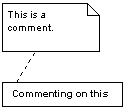
Comments. Any kind of information that isn't easily representable in UML, including comments, implementation-level code, etc. Also used for a long constraint. This symbol is used in all of the UML diagrams.
Organizational Diagrams

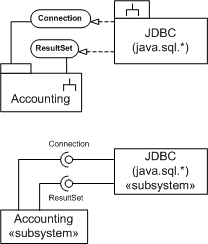
Subsystems. A subsystem is a cooperating set of runtime objects that form a cohesive group. (Packages are made up of classes, not objects. They are not the same as subsystems.) A subsystem presents a standard set of interfaces to the outside world, and all access to the objects that comprise the subsystem should be through these interfaces. If you access the subsystem via a single object whose primary responsibility is to implement an access interface(s), that object is called a port.
Packages are compile-time things, subsystems are run-time things. Don't confuse them — the similar notation is unfortunate. The classes that comprise the subsystem are often contained in a single package, but need not be. (The classes that define objects in the JDBC subsystem are defined in the java.sql package. I've shown relationship at left, but that's not standard UML.) Subsystems are identified as such by a  symbol, which can be placed in the tab or body of the box.
symbol, which can be placed in the tab or body of the box.
The diagram at left shows both the standard and ball-and-socket-style interface notations. UML also lets you put into the box a static-model diagram showing the classes that comprise the subsystem. I've found that level of detail to be unnecessary in practice, so have not shown it.
Use-Case (Story) Diagram
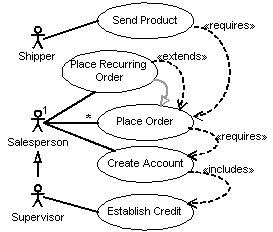
Specifies participants in a use case and the relationships between use cases. In Agile software development, these diagrams can represent stories. The diagram is useful for uncovering dependencies and deciding which of two otherwise similar stories to implement first. (All other things equal, implement the one with the most incoming arrows first.)
- The stick-figure represents a role taken on by some actor (sometimes called simply "actor," but it's really a role).
- A line connects the actor/role to the use case in which it participates. You may use cardinality. (A Salesperson places many orders.)
- An is-specialization-of/generalizes relationship between actor/roles (denoted by
 ) indicates additional responsibilities. (A Supervisor has all the responsibilities of a Salesperson, but can also establish credit. A Supervisor can create an account, for example.)
) indicates additional responsibilities. (A Supervisor has all the responsibilities of a Salesperson, but can also establish credit. A Supervisor can create an account, for example.) - Dotted lines denote use-case dependencies. Common dependencies are:
«equivalent» Equivalent use cases have identical activities and identical flow, but end users think of them as different. ("Deposit" and "Withdrawal" might have identical activities, though the objects involved might be different.) «extends» When extension extends base, all the activities of the base use case are also performed in the extension use case, but the extension use case adds additional activities to —or slightly modifies existing activities of—the base use case. (To place a recurring order, you must perform all the activities of placing an order plus set up the recurrence.) If a set of activities occur in several use cases, it's reasonable to "normalize" these common activities out into a base use case, and then extend it as necessary.
Holub Extension: This relationship is really a form of derivation, so I use the derivation arrow (
 ) instead of a dashed line. As in a class diagram, the arrow points from the extension to the base use case.
) instead of a dashed line. As in a class diagram, the arrow points from the extension to the base use case. «includes» A subcase. If case includes subcase, then the activities of subcase are performed one or more times in the course of performing case. (An "Authenticate" subcase may be included in several larger use cases, for example.) The subcase is usually represented in the using use case as a single box marked with the subcase name and the stereotype «use case». «requires»
«follows»If follower requires leader, then leader must be completed before you can execute the follower use case. (You must create an account before you can place an order.) «resembles» Two use cases are very similar, but do have different activities.
Actors/roles are mostly uninteresting to programmers. The dependencies are valuable in determining which use case to implement first. (I often implement the use cases that have the most incoming arrows first, since other use cases depend on them.)
Activity and State Diagrams
State diagrams share many notational elements with activity diagrams. The main difference is that state diagrams "decorate" the transitions (directed lines between states) to indicate the method call or condition that caused the transition.
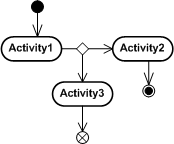
Starting and Stopping. The solid circle indicates the beginning of the sequence of activities.
The circle with an X represents an end of a "flow" but not the end of the entire use case. In other words, some subtask completes, but the entire use case is not yet complete.
The "target" indicates that the entire use case is complete.
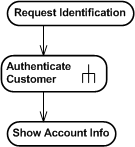
Subcase (Sub-Activity). The "rake" symbol indicates that the "activity" is complex enough to merit its own activity diagram. In use-case analysis, this is a "subcase"---a stand-alone activity that occurs in more than one use case but is not large enough to be a use case in its own right.
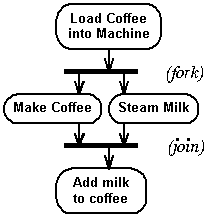
Synchronization (Fork/Join). Used either when several activities can go on in parallel or when the order in which a set of activities execute is immaterial. The heavy bar at the top is a fork. After the fork, all activities can (but are not required to) go on in parallel. Progress cannot continue past the bar on the bottom (the join) until all the activities that feed into the join complete.
You can label the join with a constraint (e.g. {joinspec= (A and B) or C}) to specify the condition that allows progress to continue. If there's no constraint, AND is assumed.
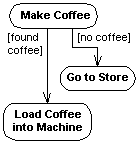
Guards (tests) This path is used only if the text in the brackets is true.

Decision (Branch/Merge). A decision activity, the guard labels the decision that was made. The diamond with outgoing arrows (the branch) specifies an OR operation, with a condition imposed by the guard. The diamond with incoming arrows (a merge) simply provides an end to the OR operation. A merge can occur without an associated branch if the diagram has multiple start states.

Signals (Events).
Generating signals: sent to outside process (Request Payment in diagram).
Accepting signals: received from outside process (Payment Received in diagram).
Timer signals: received when time elapses or a set time arrives (30 days... in diagram).

Exceptions. Extraordinary errors that you typically don't detect with explicit tests are indicated with a "lightning bolt."

Object Flow. Identifies objects that are created by activities (box with outgoing arrow) or used by activities (box with incoming arrow).
In the example at left, The invoice object is created during the receive-invoice activity and used by the process-invoice activity. The check object is created in the cut-check activity and is used by the send-payment activity. In this second case, you can also put boxes at both ends of the line.
You can indicate exactly how the object is used with a constraint. (e.g. {create}, {store}, etc.)

Swim Lanes. Activities are arranged into vertical or horizontal zones delimited with lines. Each zone represents a broad area of responsibility, typically implemented by a set of classes or objects. For example, the swim lane labeled accounting could represent objects of several classes (Bookkeeper, Clerk, MailRoom, Accountant) working in concert to perform the single "cut paycheck" activity.
UML 2.x (bottom diagram at left) uses solid rather than dashed lines, and permits both horizontal and vertical (or both) delimitation. The upper left quadrant in the diagram at left represents accounting activities that happen in Paris.
Example Activity Diagram

Static-Model (Class) Diagram
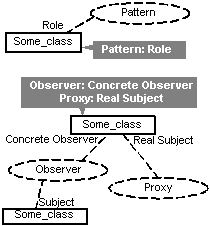
Design Pattern (Collaboration)
- The dashed circle is UML, ver. 1.5. The grey box is Erich Gamma's notation, as presented in John Vlissides' book Pattern Hatching (Reading: Addison Wesley, 1998). Use one or the other.
- A single class can have different roles with respect to several patterns. In the bottom example, the class serves as both the "Concrete Observer" in the "Observer" pattern and also the "Real Subject" in the "Proxy" pattern. The UML notation can identify all participating classes if they happen to be in physical proximity.
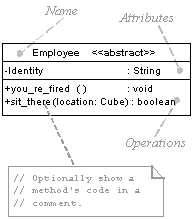
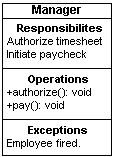
Classes. Standard representation contains three compartments:
- The name compartment (required) contains the class name and other documentation-related information: E.g.:
Some_class «abstract» { author: George Jetson modified: 10/6/2999 checked_out: y }- Guillemets identify stereotypes . E.g.: «utility», «abstract» «interface».
- Can use a graphic instead of word.(«interface» often represented as small circle)
- Access privileges (see below) can precede name
- Use italics for abstract-class and interface names.
- The attributes compartment (optional):
- The operations compartment (optional) contains method definitions:
message_name(arguments): return_type
Resist the temptation to use implementation-language syntax.Visibility (access privileges) indicated as follows:>1
+ public # protected ~ package2 - private -- implementation visibility (inaccessible to other objects)2 (+) forced public. Override of an interface method that should be treated as private, even if it's declared public.2 UML 2.0 permits C++-style grouping:
public a(): int b(): void private c(): void
Properties (new in UML 2.0.):
/ Derived attribute. Synthesized at runtime. Combine with access. (e.g. -height , -width , /+area ) {property} Standard properties are: {readOnly}, {union}, {subsets property-name}, {redefines property-name}, {ordered}, {bag}, {seq} (or {sequence}), {composite}. example:/+area: integer {readOnly} abstractoperations indicated by italics (or underline).
If attributes and operations are both omitted (yielding a box with a class name in it), a more-complete definition is assumed to be on another sheet.
Introduce nonstandard compartments simply by naming them, as is shown in the bottom example at left.
1 Java, unfortunately, defaults to "package" access when no modifier is present. UML does not support the notion of a default access. UML has no notion of "implementation visibility" (accessible only within an object — other objects of the same class cannot access it).
2 These are Allen Holub's personal extensions. The ~ was incorporated into the UML standard with version 1.5. The other's are not standard UML.

Associations (relationships between classes).
- Associated classes are connected by lines.
- The relationship is identified, if necessary, with a < or > to indicate direction (or use solid arrowheads).
- The role that a class plays in the relationship is identified on that class's side of the line.
- Stereotypes (like «friend») are appropriate.
- Unidirectional message flow can be indicated by an arrow (but is implicit in situations where there is only one role):

- Cardinality:
1 (usually omitted if 1:1) n (unknown at compile time, but bound) 0..1 (1..2 1..n) 1..* (1 or more) * (0 or more)
Example:
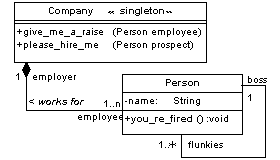
class Company { private Person[] employee=new Person[n]; public void give_me_a_raise( Person employee) { /*...*/ } public void hire_me( Person prospect ) { /*...*/ } } class Person { private String name; private Company employer; private Person boss; private Vector flunkies=new Vector(); public void you_re_fired(){...} } (A Java Vector is a variable-length array. In this case it will hold Person objects.)
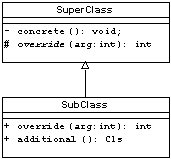
Implementation Inheritance (Generalize/Specialize)
 identifies implementation inheritance (
identifies implementation inheritance (extends in Java) The base class is a concrete class, with data or methods defined in it, as compared to an interface, which is purely abstract (in C++, a class made of nothing but pure virtual methods). The derived class is the base class, but with additional or modified properties. The derived (sub) class is a specialization of the base (super) class. Variations include:

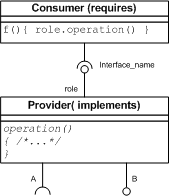
Interface Inheritance (Specifies/Refines/Implements).
An interface is a contract that specifies a set of methods that must be implemented by a derived class (in C++, a class containing nothing but pure virtual methods. Java and C# support them directly). (C.f. abstract class, which can contain method and field definitions in addition to the abstract declarations. An abstract class is extended (see implementation inheritance).
Interfaces contain no attributes, so the "attributes" compartment is always empty.
Indicate an interface inheritance relationship (implements in Java) with a dashed line. That is, use a dashed line when the base class is an interface and the derived class is a concrete class that implements the methods defined in the interface. When interfaces extend other interfaces, use a solid line.
The "ball and socket" notation at left is new in UML 2.0. Classes that consume (require) an interface display a "socket" labeled with the interface name (A at left). Classes that provide (implement) an interface display a "ball" labeled with the interface name (B at left). Combining the two is a compact way to say that the Consumer talks to the provider via the named interface.
My UML extension:  Rounded corners identify interfaces. Since rounded corners are often difficult to draw by hand, I sometimes use the version at right for hand-drawn diagrams.
Rounded corners identify interfaces. Since rounded corners are often difficult to draw by hand, I sometimes use the version at right for hand-drawn diagrams.
 Strict UML uses the «interface» stereotype in the name compartment of a standard class box. A small circle in a corner of the compartment often indicates an interface, as well.
Strict UML uses the «interface» stereotype in the name compartment of a standard class box. A small circle in a corner of the compartment often indicates an interface, as well.
If the full interface specification is in some other diagram, I use the "ball" notation or  .
.
 Microsoft-style "pin" notation (at right) is obsolete as of UML 2.0. Don't use it.
Microsoft-style "pin" notation (at right) is obsolete as of UML 2.0. Don't use it.

Nesting, Inner Class.. Identifies nesting (containment) relationships in all diagrams. In a class diagram: an "inner" class whose definition is nested within the "outer" class definition. Typically puts the inner class in the name space of the outer class, but may have additional properties.

Dependency. User uses Resource, but Resource is not a member of (field in) the User class. If Resource is modified, some method of User might need to be modified. Resource is typically a local variable or argument of some method in User. The line is typically stereotyped (e.g. «creates» «modifies»)

Aggregation (comprises) relationship relationship.1 Destroying the "whole" does not destroy the parts.

Composition (has) relationship.1 The parts are destroyed along with the "whole." Doesn't really exist in Java. In C++:
class Container { Item item1; // both of these are Item *item2; // "composition" public: Container() { item2 = new Item; } ~Container(){ delete item2; } } 
Navigability Messages flow in direction of arrow (only). An unmarked line is "unspecified" navigability. An X indicates non-navigable (Uml 2.0).
Typically, if a role is specified, then navigability in the direction of that role is implicit. If an object doesn't have a role in some relationship, then there's no way to send messages to it, so non-navigability is implicit.

Constraint A constrained relationship requires some rule to be applied. (e.g. {ordered}) Often combined with aggregation, composition, etc.
Complex Constraint
Comments
- In the case of the or, only one of the indicated relationships will exist at any given moment (a C++
union). - Subset does the obvious.
- In official UML, put arbitrary constraints that affect more than one relationship in a "comment" box, as shown. I usually leave out the box.
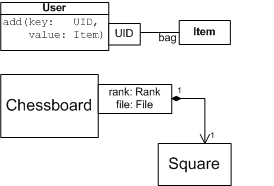
Qualified Association (hash-table, associative array, "dictionary"). Use an external (or "foreign") key to identify an object that does not contain that key. Eg.: A bank uses a Customer to identify an Account because accounts do not contain customers. (An account is identified by an account number, not a customer.)
class User { // A Hashtable is an associative array, // indexed by some key and containing // some value; in this case, contains // Item objects, indexed by UID. private Hashtable bag = new HashTable(); private void add(UID key, Item value) { bag.put( key, value ); } } 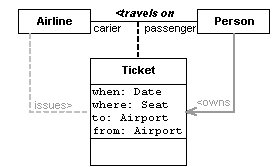
Association Class
- Use when a class is required to define a relationship.
- If this class appears only as an association class (an class-to-class association like the one between Person and Ticket doesn't exist), objects of the association class must be passed as arguments to every message.
Example Class Diagram

Interaction (Dynamic-Model) Diagrams
"Interaction" diagrams show the "dynamic model." They show how objects interact at run time: how they act out a use case by sending messages to each other.
There are two sorts of interaction diagrams: Sequence Diagrams and Collaboration/Communication Diagrams. The two forms present identical information in different way. Which one you use is largely a matter of taste. Sequence diagrams tend to be more readable, collaboration diagrams are more compact.
Sequence Diagram
Without Activations:
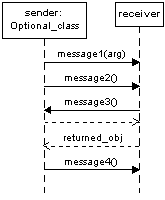
With Activations:
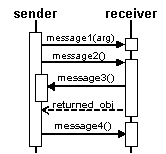

Data "Tadpoles"
Data "tadpoles" are often more readable than return arrows or message arguments. At left, the entryClerk object sends the shippingDock an object called order. The shippingDock returns the shippingReceipt object.

Object Creation
- Name box appears at point of creation.
- «creates» form for automatic creation. In C++: An object (not a reference to one) is declared as a field in a class. The closest Java equivalent is an object created by instance-variable initialization:
class X { private Cls o = new Cls(); //... } - If message shown instead of «creates», then the message handler creates the object. Think of
new Fred()asFred.new(). Method does not have to benew().
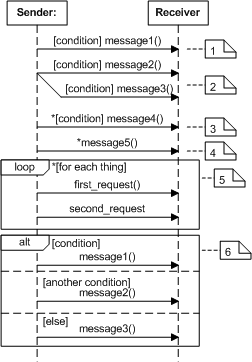
Conditions, Branches, Loops, Grouping
-
message1()is sent only if the condition specified in the guard (in brackets) is true. - A branch. Sender sends either
message2()ormessage3(). Guards should be exclusive. I use «else» instead of a guard when appropriate. - Iteration. Sender sends
message4()as long as the condition is true. - "For each." If the receiver is a collection of objects (indicated by the cardinality of the associated role in the static model), send the message to all of them.
- UML 2.0 Interaction Frame. As shown, condition specifies a loop. Can also use:
loopA loop, executes multiple times optOptional. An "if" statement. regionA named region. refA reference to a named region (elsewhere in diagram or on another diagram): 
- As shown, an if/else structure. Can use:
altExecute one of the alternatives, controlled by guards parExecute regions in parallel
Interaction frames can nest: 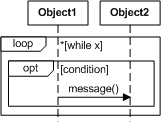
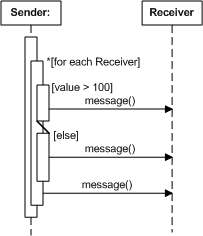
Alternative (Nonstandard) Branch/Loop Notation Use "pseudo-activations" and guards to indicate control flow.
Diagonal line indicates an "alternative" flow.

Loops, Alternative (My own extension to UML.)
- Don't think loops, think what the loop is accomplishing.
- Typically, you need to send some set of messages to every element in some collection. Do this with every.
- You can get more elaborate: "every receiver where
x<y". - The diagram at left comes from this model:

and maps to the following code:class sender_class { receiver_class receiver[n]; public do_it() { for( int i = 0; i < n; ++i ) receiver[i].message(); } }
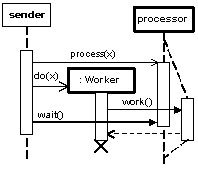
Active Objects
Active objects process messages on one or more auxiliary background threads. They are are indicated by a heavyweight outline. The messages sent to an active object are typically asynchronous: they initiate some activity but don't wait around for the activity to complete.
- The "stick" arrowhead means asynchronous message — the call returns before message is fully processed. A return value from an asynchronous message can indicate that work started, but can't indicate any sort of completion status.
- The box on the lifeline means activated — some activity is being performed by the object, perhaps on a background thread.
- A separate lifeline [shown at left when the
work()message activates theprocessorobject] implies a separate thread for processing the message. - The large X indicates that an object deletes itself when done handling message. An external kill is represented as:

At left, the process(x) message activates processor. The process(x) message is asynchronous, so the requesting method returns immediately and the processor object does the work in the background. While process(x) is being handled, the sender object sends a do(x) message, which brings an anonymous Worker object into existence. (The do() method is a static method of the Worker class that creates an anonymous object to handle the request.) This anonymous object does some work, sending a synchronous work() message to the processor object. Since the work() handler is synchronous, it doesn't return until the work is complete. The anonymous worker waits for work() to return, then deletes itself (killing any associated threads). The processor object continues to exist, waiting for something else to do.
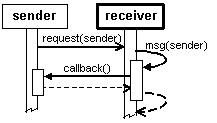
Callbacks, Recursion
At left, the sender sends an asynchronous message to the active-object receiver for background processing, passing it the object to notify when the operation is complete (in this case, itself). The receiver calls it's own msg(...) callback() call when it's done. Note that:
- The
callback()message is running on thereceiverobject's message-processing thread. - The
callback()method is, however, a member of thesenderobject's class, so has access to all the fields of thesenderobject. - Since the original thread (from which the original
request()was issued) is also running, you must synchronize access to all fields shared by bothcallback()and other methods of thesenderobject.
Example Sequence Diagram
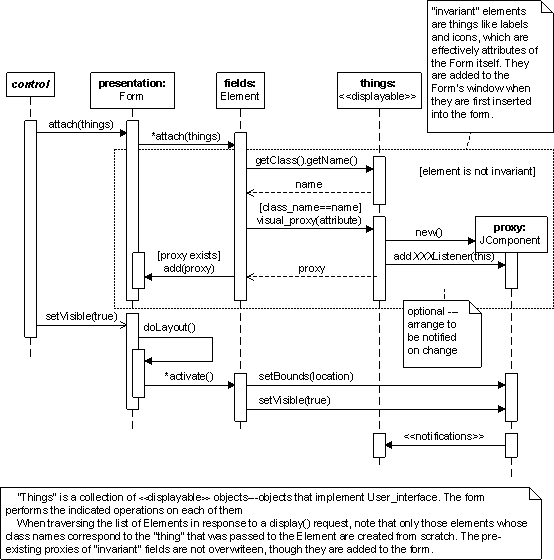
Collaboration (Communication) Diagram
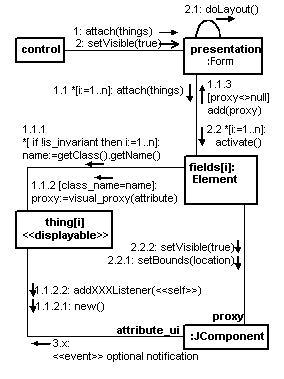
Collaboration (renamed "Communication" in UML2) Diagrams are an alternative presentation of a sequence diagram. They tend to be more compact, but harder to read, than the equivalent sequence diagrams. The example at left is identical in meaning to the Sequence-Diagram example at the end of the previous section. (It represents the same objects and message flow.)
The boxes are objects. Lines connecting two boxes indicates that the objects collaborate with (send messages to) one another. Use a multiplicity indicator in the box (such as *) to indicate that all elements of an aggregation receive a message.
The object name typically goes inside the box, but can go outside the box when different collaborators refer to it by different names. E.g.: the JComponent at the lower right of the diagram is referenced by Element objects through a field called proxy it's referenced from thing[i] via a field named attribute_ui.
Use the following qualifiers on names:
| «parameter» name | Method parameter. |
| «local» name | Local variable. |
| name {new} | Object created during execution |
| name {destroyed} | Object destroyed during execution |
| name {transient} | Object created during execution, used, then destroyed |
Usually, the instance name (or reference through which the instance is accessed) is the same as the role the instance plays in the collaboration. When the name and role aren't identical, use instance/role:Class. E.g.: given tutor/teacher:Person and lecturer/teacher:Person, an object of class Person, used in the role of teacher, is called tutor in some portion of the code and lecturer elsewhere in the code.
Messages that flow from one object to another are drawn next to the line, with an arrow indicating direction. Arrowhead types have the same meaning as in sequence diagrams. The message sequence is shown via a numbering scheme. Message 1 is sent first. Messages 1.1, 1.2, etc., are sent by whatever method handles message 1. Messages 1.1.1, 1.1.2, etc., are set by the method that handles message 1.1, and so forth. Message sequence in the current example is:
1.
1.1
1.1.1
1.1.2
1.1.2.1
1.1.2.2
1.1.3
2.
2.1
2.2
2.2.1
2.2.2
3.
Guards are specified using the "Object Constraint Language," a pseudo-code that's part of the UML specification. Syntactically, it's more like Pascal and Ada than Java and C++, but it's readable enough. (The operators that will trip you up are assignment [:=] equality [=] and not-equals [<>]). As in a sequence diagram, an asterisk indicates iteration.
Nomeclature
There are three broad categories of diagrams.
- Structure Diagrams
- include class diagrams, deployment diagrams, etc.
- Behavior Diagrams
- include activity, use-case, and state diagrams.
- Interaction Diagrams (are a subclass of Behavior Diagrams)
- include Sequence and Collaboration diagrams.
Collaboration diagrams are called "Communication Diagrams" in UML 2.
What's Missing
A few parts of UML aren't shown here. (Some of these are useful, I just haven't gotten around to adding them yet.)
- State-Diagram Symbols. There are a few symbols used in state diagrams that aren't shown in the earlier Activity/State-Diagram section.
- Deployment diagrams. Show how large modules in the system hook up. Useful primarily for marketing presentations, executive summaries, and pointy-haired bosses.
- Parameterized Classes. C++ templates/Java generics.
- N-ary Associations. are better done with classes. Don't use them.
- Component Diagrams. The only difference between a component and a subsystem is size. Component diagrams are almost identical to subsystem diagrams.
- Activity Realization Diagram. is an activity diagram redrawn to look more like a collaboration-diagram.
Refer to the UML Superstructure document for more details.
Footnotes
(1) Composition vs. Aggregation:
Neither "aggregation" nor "composition" really have direct analogs in many languages (Java, for example).
An "aggregate" represents a whole that comprises various parts; so, a Committee is an aggregate of its Members. A Meeting is an aggregate of an Agenda, a Room, and the Attendees. At implementation time, this relationship is not containment. (A meeting does not contain a room.) Similarly, the parts of the aggregate might be doing other things elsewhere in the program, so they might be referenced by several objects. In other words, There's no implementation-level difference between aggregation and a simple "uses" relationship (an "association" line with no diamonds on it at all). In both cases an object has references to other objects. Though there's no implementation difference, it's definitely worth capturing the relationship in the UML, both because it helps you understand the domain model better, and because there are subtle implementation issues. I might allow tighter coupling relationships in an aggregation than I would with a simple "uses," for example.
Composition involves even tighter coupling than aggregation, and definitely involves containment. The basic requirement is that, if a class of objects (call it a "container") is composed of other objects (call them the "elements"), then the elements will come into existence and also be destroyed as a side effect of creating or destroying the container. It would be rare for a element not to be declared as private. An example might be an Customer's name and address. A Customer without a name or address is a worthless thing. By the same token, when the Customer is destroyed, there's no point in keeping the name and address around. (Compare this situation with aggregation, where destroying the Committee should not cause the members to be destroyed---they may be members of other Committees).
In terms of implementation, the elements in a composition relationship are typically created by the constructor or an initializer in a field declaration, but Java doesn't have a destructor, so there's no way to guarantee that the elements are destroyed along with the container. In C++, the element would be an object (not a reference or pointer) that's declared as a field in another object, so creation and destruction of the element would be automatic. Java has no such mechanism. It's nonetheless important to specify a containment relationship in the UML, because this relationship tells the implementation/testing folks that your intent is for the element to become garbage collectible (i.e. there should be no references to it) when the container is destroyed).
Source: https://holub.com/uml/
Posted by: lecyashleyayes.blogspot.com

0 Komentar